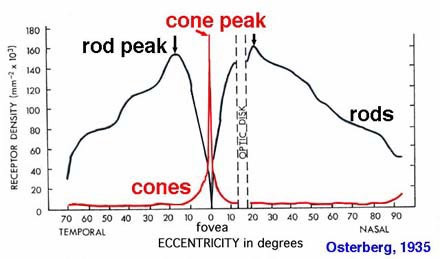Night Vision
In humans, day and night vision are achieved through different mechanisms. Vision in low light is achieved exclusively by rod cells. Rods cells can be activated by on photon of light while cone cells must receive several hundreds of photons to be activated. Because rods are so easily activated, they are ideal for vision under low-light conditions. Once a rod cell is activated, retinal is no longer bound to opsin and the rhodopsin molecule no longer exists. Once activation is complete the new all trans retinal does not convert back to 11-cis-retinal. Instead, the retinal cell must produce another 11-cis-retinal to bind to opsin to produce rhodopsin. While the most rhodopsin can be generated in as little as five minutes, full recovery does not occur for thirty minutes. Because of this, a person does who enters a dark room after been in a lighted room or in sunlight will not have full night vision for thirty minutes.
Interestingly, rod cells are absent in the fovea, the region of the retina that represents the center of vision, but rods are by far the more abundant than cones in all other regions of the retina. See below.

Because rods are absent from the fovea, it is often impossible to perform simple tasks that require fine vision even under a "bright" full moon that activates rod, but not cone cells. In addition, under low light conditions during which rod cells are activated, but cone cells are not, color determination is impossible. This is because there is only one rod photopigment. Color vision is possible under high light scenarios because there are multiple photopigments in cone cells and relative levels of activation can be compared to determine color. See the color vision page for more detail on this.
http://www.phys.ufl.edu/~avery/course/3400/vision/rod_cone_distribution2.jpg